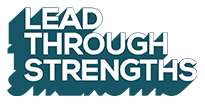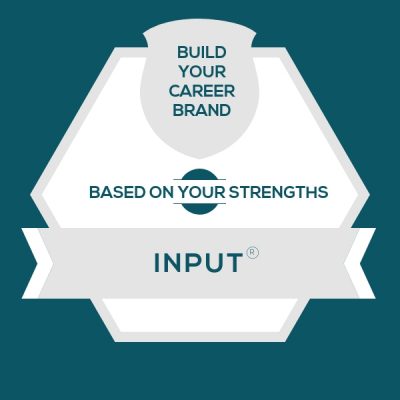Input Strength: Build A Genuine Career Brand
Podcast: Play in new window
Subscribe: Spotify | iHeartRadio | Email | TuneIn | More
Input Strength: Get Known For Your Talent
I get a whole lot of questions about how to amplify your CliftonStrengths talent theme of Input with your career.
In this series, I break down one strength per post — so that you can add to the insights from your StrengthsFinder report and make a better alignment between your job and your strengths.
- If you’re exploring this concept as a manager, use this series for career development ideas and even new clues about responsibilities you could give a person with this talent theme so that they can show up at their best.
- If you’re exploring this concept for yourself, use this as a chance to build a reputation for your strengths so that you’re more likely to be given assignments that live in your strengths zone.
You’ll get three layers to chew on:
1. Career Branding
2. Red Flag Situations At Work
3. Fresh Application Ideas
Personal Branding For The Input Strength
You probably already have a reputation for what you know. Think about your personal resume, CV, or your LinkedIn profile, I bet it's full of “the what,” which are things like job titles, skills, knowledge, expertise, or the degree you earned. What’s missing is usually "the how,” and this is where your StrengthsFinder talent themes live.
Chances are good that you are a lot like my StrengthsFinder training clients, where you don’t physically see your teammates and customers every day. That’s why LinkedIn has become so important for career branding. It’s how your teammates, customers, and vendors go look you up before a meeting - to see who they’re about to talk to. And rather than only telling them what you know, you should also give them a peek at how it is to work with you.
Here are a bunch of adjectives to consider using in your career branding efforts and your LinkedIn profile when you lead through the Input strength:
- Inquirer
- Collector
- Information Sponge
- Generous
- Applier
- Well-Read
- Knowledgeable
- Researcher
- Investigator
- Corporate Librarian
- Company Archivist
- Curator
- Workplace Archeologist
Red Flag Situations When You Lead With The Input Strength
These are the cultures, interactions, or situations that feel like soul-sucking drudgery to someone with the talent theme of Input. They might even make you want to quit the team. So I’ll give you a couple of these to be on watch for — because if they fester, you might get the urge to quit the job or become detached and disengaged at work.
Here are a couple of Red flags for the Input strength (talent theme):
- Busy work. Because people with Input like to learn and then aim that learning at something useful, it’s really draining to do tasks that seems like “make work.” If you lead through the Input strength and you see this happening, challenge yourself to share insights or document the process to make it useful to someone else. This way, you can still feel like you’re curating something useful to teammates.
- Outdated or unsearchable tools. If you lead through the Input strength and you see something like a database or CRM system or customer service tool that is not kept current, it will be draining. You’ll be able to see the huge value in sharing information, and it will be extremely frustrating to find that others don’t value the repository in the same way.
3 Fresh Application Ideas For The Input Strength
These are ways to apply the talent theme of Input at work , even when the job duties on the team feel pretty locked in. If you’re exploring this concept as a team manager, be sure to have a conversation around these ideas. You’ll both be able to come up with places to apply them.
For someone who leads through the Input strength, put the talent to good use with one of these options:
- Make information findable. If you lead someone with Input and you want a system for curating, storing, and finding information that everyone can use, send it over to someone with Input. Whether you ask them to make a Wiki or update an intranet page or collect FAQs, the idea of gathering and sharing useful information will light up someone with Input.
- Research deeply. When you need someone to do a deep research quest, ask someone with Input. They’ll enjoy looking through archives, learning, and then distilling the important parts down to make them usable to others. The idea of researching and applying is highly energizing for those who lead through Input. And then translating them into usable bits will be a fun way for them to apply the information while being challenged to distill the important takeaways.
- Soak up practices from other teams. Basically, ask them to be a sponge and soak up the approaches that others are using. Then they can apply it to your team’s specific situation and make recommendations. The idea of investigating the options by being curious inquirer will be fun. From there, applying it to your team adds to the energy because someone with Input wants to apply the learning to a specific project or situation.
So there you have it. It’s a quick tour for building your career through the talent theme of Input.
Here's Your Personal Branding Homework For The Input Strength
- Go take action on your LinkedIn profile with the career branding section. Challenge yourself to write one sentence in the Summary section of LinkedIn that captures how you collaborate as a teammate at work.
- Then think over the red flags to see if there’s anything you need to get in front of before it brings you down.
- Volunteer your talents through the application ideas. And if you’re a manager, have a conversation with your team members about which of these things sound like something they’d love to have more of.
- Dig into the Input strength all the way. You can really nerd out on the nuances on the Input Talent Theme Page.
Rock Your Talents As A Team
If you’re thinking about doing a virtual or in-person event to kick off your strengths-based culture, head on over to our training page to see if our current offerings are a good fit for you. Until next time, thank you for being part of this powerful strengths movement that helps people unleash the awesomeness already inside them.
Enjoyed The Podcast?
To subscribe and review, here are your links for listening in iTunes and Stitcher Radio. You can also stream any episode right from this website. Subscribing is a great way to never miss an episode. Let the app notify you each week when the latest episode gets published.
Here's A Full Transcript Of The 9 Minute Episode on Your Input Strength
You're listening to Lead Through Strengths, where we help work teams apply their greatest strengths in the workplace. I'm your host, Lisa Cummings and I got to tell you, it's hard to find something more energizing than using your natural talents every day at work. I get a lot of questions from people gathering up ideas for how to apply CliftonStrengths talent themes to their careers, especially with Input. You voracious learners you, lots of people gathering.
So, in this series, you'll get one strength broken down per episode. That way you can add to the insights that you already have from your StrengthsFinder report, and then make an even deeper match between your job and your strengths. If you're listening with your manager hat on, use this series for career development ideas. Think about how to map the responsibilities and tasks you assign on the job, and give them to people with this talent theme so they can show up at their best.
If you're listening for yourself, because you lead through the talent theme of Input, use this as a chance to build a reputation for your strength so that you're more likely to be given assignments that live in your strength zone.
[1:17]
So today, you've already heard the word Input. So, you know, the talent theme of the episode is Input. You're going to get three layers to chew on. Career branding is number one. Red flag situations at work as number two, and fresh application ideas is number three.
So we'll jump right in with career branding for Input. Now, you probably already have a reputation for what it is. You know, think about your personal resume, your CV, or your LinkedIn profile, is probably full of the ‘what’ things like job titles, skills, knowledge, expertise, or the degree you have. What's missing is usually the ‘how’, and this is where your StrengthsFinder talent themes live.
Chances are good that you're like a lot of my Strengths Finder training clients where you don't physically see your teammates and customers every day. And that's why LinkedIn has become so good for career branding, because it's how those same people, your teammates, your customers, your vendors, they go look you up before meetings to see who they're about to talk to.
And rather than only giving them the information of the ‘what’ stuff, the job titles and experiences and skills, you should give them a peek at how it is to work with you so that they can think of you and your strength zone, so that you can begin building the reputation around that before you even meet.
So here are a bunch of Input-related adjectives to consider using in your career branding efforts and in your LinkedIn profile. So, think of you and think of the ones that seem to resonate and reflect you the best.
Enquirer, collector, information sponge, generous applier of knowledge, well-read, knowledgeable researcher, investigator, corporate librarian, archivist, curator, workplace archaeologist.
So, you can see some of those are fun and a little bit creative. One guy kind of tweaked them the other day and did corporate archaeologists, and he thought that was the best. So, it went right in the profile.
So, let's move to red flag situations for Input. This is more of the potential downside. Now these are the cultures, the interactions, the situations, these are the things that could really feel like soul-sucking drudgery to someone who has the talent theme of Input right there at the top. These situations might even make you want to quit or detach or disengage from the team. So watch out for these here are two important ones.
One is busy work.
[3:43] Well, people with Input like to learn and then they like to aim the learning at something that's actually useful. So, as you can imagine, if you want to be useful, then it's really draining to do tasks that seemed like make work. So, if you lead through Input, and you see this happening, you just don't know the meaning of the work and you think it's just busy work.
Challenge yourself to do something extra with it, share insights, document the process so that it's useful later. Try to standardize the procedure, do something so that you make it useful and aim it at progress. This way, you can still feel like you're curating something that's useful to teammates.
[4:21]
Number two, outdated or unsearchable tools. If you lead through Input, and you see something like a database, or a CRM system, or a customer service tool that is not kept current, and you're trying to use it, it's really going to be draining. Now you'll be able to see big value in sharing this information and using this information. So, it's probably really frustrating to you to imagine that others don't find the value in that repository in the same way. So obviously, you can do a lot of things to get around it. You might find that that culture is just not a match for you.
But if you want to be more productive with it, you could say, -
“Hey, I'm going to go on a campaign to help people understand how valuable this tool can be.”
“I'm going to start pulling out insights and sharing them.”
“I'm going to start helping other people understand just how awesome this database could be if the data were cleaned up.”
And maybe you go on a campaign to clean up the data and make it an awesome tool again. So that's a way to turn around the unfortunate situation and get some energy out of it and turn it into something great.
Alright, let's move to the third one. This is application ideas for Input so here are some ways to apply this talent theme at work. Even in a situation where job duties seem pretty well laid out, like you don't have a lot of leeway and what the job duties can be, these are some ways you can apply the ‘how’ part at work to volunteer these talent themes.
Now, if you're listening in as a team manager, have conversations around these ideas, and come up with ways to build on these ideas and use them. Alright, if you lead through Input, here's how you can put this talent to good use.
Idea one, make information findable for you and for someone else, because if you lead through Input, and you want a system for curating and storing and finding information that everyone can use, it's going to benefit you and them and it'll be fun to build. So that could be making a wiki, that could be updating an intranet page, it could be collecting FAQ's. Whatever the thing is that you find yourself gathering and pulling together, put it in a place where it's reusable by you and other people. That's a good way to light you up if you have Input.
The second idea is research, deep research. So, if you think about a manager who needs someone to do a really deep research quest, hey, ask someone Input. They're going to love looking through archives and learning and then distilling the important parts down, and then summarizing them and making them usable for other people.
The idea of researching and then applying is really energizing for those who lead with Input, especially if it's something new, where you can take curiosity and variety and bring it into the mix, but also make it useful. And then the idea of thinking through it and translating that into usable bits, that's a fun way to apply the information while still being challenged, because you have to distill the important takeaways.
Third application idea, soak up practices from other teams. So, if you're a manager, and you're thinking, - “Ooh, what could I assign to this person?”, ask him to be a sponge and soak up the approaches that other people are using, and to vet them.
- What could you take on that's good?
- What could you learn from the mistakes, and then apply it to your team's specific situation and get recommendations out of it?
This whole idea of investigating the options by being a curious enquirer type, that'll be really fun to someone who has the Input talent. And then from there, getting to apply it to the team, that's going to add to the energy because someone with Input also wants to apply the learning to a specific useful project or situation.
So, there you have it. It's a quick tour for building your career through the talent theme of Input.
So, here's your homework:
Number one, take action on your LinkedIn profile with the career branding section. Challenge yourself to write one sentence in the summary section to capture how you collaborate as a teammate at work.
Then think over the red flags to see if there's anything you need to get in front of before brings you down.
And then finally, number three, volunteer your talents through those application ideas. And if you're a manager, have a conversation with a team member and find something that sounds like they'd love to have more of.
With that, I'm your host Lisa Cummings from Lead Through Strengths. And if you're thinking about doing a virtual or in person event, to kick off your strengths-based culture, head over to leadthroughstrengths.com/training . Check it out and see if our current options and offerings look like they might be a good fit for you.
So, until next time. Thank you for being part of this powerful strengths movement that helps people unleash the awesomeness that already lives inside them.
Carmie is a professional writer and editor at Lead Through Strengths. Having spent 8 happy years with a nonprofit child organization as a storyteller and sponsorship relations team manager, she continues collaborating with others across the globe for the joy of human development and connection. Her days are powered by coffee, curiosities, cameras (film and digital), music, notebooks, and a cat. Where books are home, she’s home. She calls her Top 5 StrengthsFinder Talents “CLIPS” (Connectedness, Learner, Intellection, Positivity, and Strategic)–you know, those tiny objects that hold connected things together. She’d like to think she’s one.


